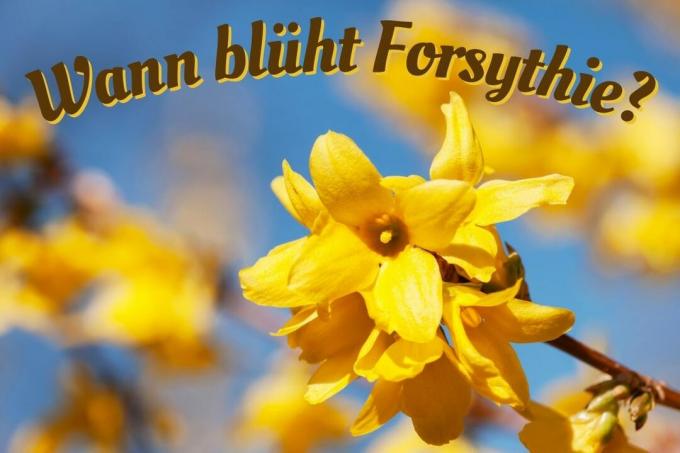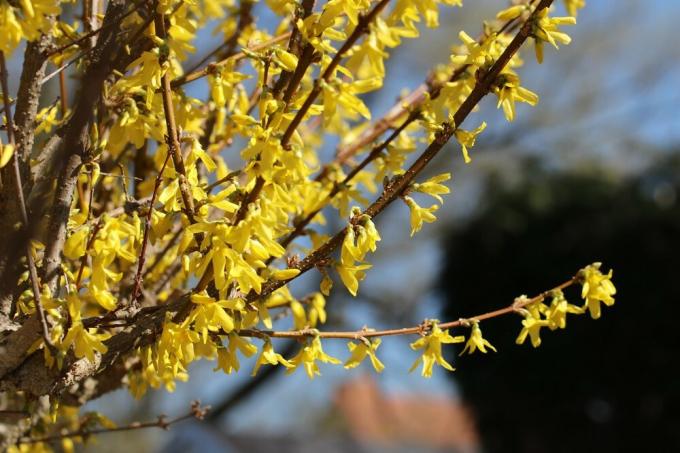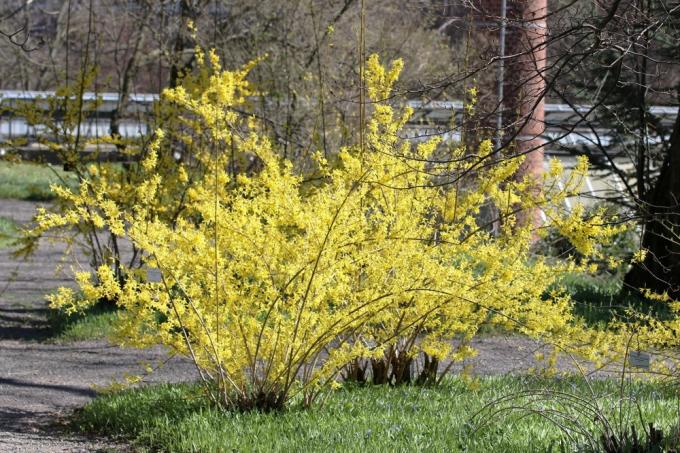
table of contents
- Forsythia: flowering period
- Region-specific flowering times
- Flowers not frost-proof
- frequently asked Questions
Forsythia are among the most important pointer plants in the phenological calendar. Its golden yellow bloom heralds first spring. At this point you can expect significantly less frost. Here you can find out everything you need to know about the forsythia bloom.
In a nutshell
- Forsythia bloom in early spring
- phenological pointer plant
- Date depends on the region
- Late frosts are harmful
Forsythia: flowering period
The flowers of the genus Forsythia belong to the impressive flowering shrubs that usher in the first days of spring. The golden lilac's heyday extends over a long period of time:
- Start: beginning of March (rarely earlier)
- End: mid-May (less often later)
This period makes it so important as a phenological indicator plant. The heyday of forsythia marks the beginning of a new period in the phenological calendar. The first spring is especially important for gardeners, because certain tasks have to be done in the garden. For example, when the forsythia blooms, roses are cut.

Region-specific flowering times
A special feature of the forsythia flower is its dependence on the region. The weather and climate in the respective region determine the date on which the forsythia blooms in the specified time frame. Examples for clarification:
- Southern Germany or Rhineland: beginning of March (rarely end of February)
- Northern Germany: late March or early April
- Finland: mid-May
- France: early March
As you can see, the flowers show up at different times. You should keep this in mind when cultivating. You must also consider the weather factor. For example, if winter is milder or colder than usual, the flowers appear a few days later or earlier.
Note: Compared to willows (Salix), forsythia do not provide food for pollinators such as bees. Despite their abundance of flowers, they are therefore unsuitable as a bee pasture in spring.
Flowers not frost-proof
However, the heyday of the forsythia has one major disadvantage: the golden yellow splendor is susceptible to frost. Regardless of their variety, forsythia lose their flowers when sudden late frosts set in. The flowers will die within a few days and you will have to wait until the next year for new ones to form. Because of this, it cannot always be said with certainty whether forsythia flower is safe. If you live in a region that often has to struggle with late frosts, you should reconsider planting a golden lilac.
Note: Winter protection for the flowers is unfortunately not effective in late frosts. This is even the case with potted plants, as only the planter is packed.

frequently asked Questions
These are special species that bloom or lose their foliage at a certain point in the year. Through these processes, the gardener orientates himself towards nature and uses it to carry out certain gardening work, such as sowing biennial plants.
When the forsythia blooms, it's time to cut the roses in spring. Since gold lilacs only bloom when it is warm enough, the freshly cut roses are rarely damaged by frost. However, pay attention to whether flowering occurs suspiciously early. In this case, late frosts can follow, which also severely affect the rose.
If there are no late frosts, but the golden lilac does not present itself in a yellow flower dress, it was probably cut incorrectly. If they are cut before flowering or if older shoots from the previous year are removed, flowering is greatly inhibited. The best time to cut is right after flowering, when they have turned brown.
Due to the rising temperatures, the forsythia bloom time can shift a little further into the year. According to the NRD (source: https://www.ndr.de/ratgeber/klimawandel/Wo-sich-der-Klimawandel-in-Norddeutschland-zeigt, phaenologie102.html) For example, the goldilocks now often bloom as early as the end of March in northern Germany, not in mid-April. This development is visibly disrupting the phenological calendar.


